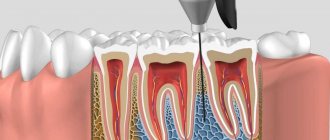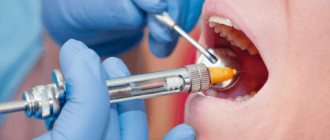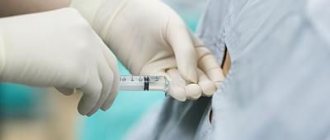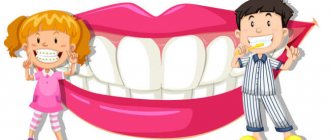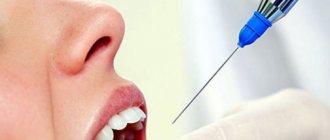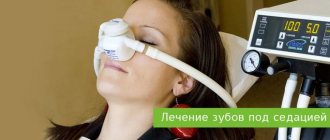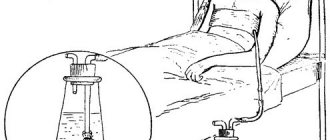What is
Local mandibular (from Latin mandibula
– lower jaw) anesthesia refers to the conduction method and involves depriving the entire lower jaw of sensitivity. The anesthesia zone covers not only the teeth, but also bone tissue, gums, mucous membranes, the lower lip and even part of the tongue.
Anesthesia according to Bershe-Dubov involves a special method of performing a mandibular blockade. Namely, the place of needle insertion and its advancement. The methodology was developed not as a result of joint work, but separately. But the French doctor Jean Henri Bercher was the first to come up with a special technique in 1922. Soviet dentist M.D. Dubov, based on the practice of his foreign colleague, proposed a slightly different method, which is still used today.
By the way! This blockade is carried out not only during dental operations, but also during painful therapeutic manipulations, for example, when realigning the lower jaw after a fracture or when cutting out an abscess in the anesthesia zone.
Trunk anesthesia according to Bershe, Bershe-Dubov, Uvarov, Weisblat
Read:- B) hemianesthesia on the opposite side
- Anesthesia
- Anesthesia
- Anesthesia
- Anesthesia
- Anesthesia
- Anesthesia
- Anesthesia
- Anesthesia
- Anesthesia
Trunk anesthesia - an anesthetic solution is injected along the nerve innervating this area.
Anesthesia according to Bershe and Bershe-Dubov are types of mandibular anesthesia, or rather, subzygomatic methods of its implementation.
Anesthesia, proposed by Berchet , is designed to block the motor fibers of the inferior alveolar nerve. The main indication for its implementation is inflammatory contracture of the masticatory muscles.
Technique : To switch off the masticatory nerve, the needle is injected perpendicular to the skin under the lower edge of the zygomatic arch, moving anteriorly from the tragus of the auricle by 2 cm. The needle is advanced horizontally to the midline to a depth of 2.0-2.5 cm through the notch of the lower jaw . 3-5 ml of anesthetic is injected. The effect of anesthesia is determined after 5-10 minutes and is expressed in the relaxation of the masticatory muscles.
Dubov modified the type of anesthesia proposed by Bershe. With Bershe-Dubov anesthesia, the inferior alveolar and lingual nerves are blocked.
Bershe-Dubov technique The needle is inserted directly under the lower edge of the zygomatic arch, 2 cm anterior to the base of the ear tragus. The needle is advanced 3-3.5 cm inward, introducing an anesthetic. 3-5 ml of anesthetic is injected.
Anesthesia zone : teeth on the lower jaw of the corresponding half, the mucous membrane along with the alveolar process on the side where anesthesia is performed, the skin of the chin area, the sublingual area, the tip of the tongue, the skin and mucous membrane of the lower lip.
Anesthesia of the third branch of the trigeminal nerve according to V.M. Uvarov .
Technique : insert a needle under the zygomatic arch 2 cm anterior to the tragus of the ear, advancing the needle deep into the soft tissues so that it passes through the notch of the mandibular branch immediately in front of the condylar process, and, plunging it 4-4.5 cm deep, reaches foramen ovale, where 5-6 ml of anesthetic is injected.
Subzygomatic method of anesthesia of the second and third branches of the trigeminal nerve ( according to Weisblatt ).
Injection technique : Using a sterile ruler under the zygomatic arch, measure the distance from the tragus of the auricle to the outer edge of the eye and mark the middle of this distance on the skin. A sterile rubber circle with a diameter of about 5 mm is threaded onto a 6 cm long needle and the needle is placed on a 10 gram syringe. At the marked point, a needle is inserted and, using an anesthetic solution, it is advanced perpendicular to the surface of the skin until it stops at the outer plate of the pterygoid process. Having marked the depth of immersion of the needle with a rubber circle, it is brought out approximately half of the marked distance. To anesthetize the second branch of the trigeminal nerve, the needle is directed anteriorly at an angle of 20-25°, without changing its position in the horizontal plane. Having moved it deeper to the length marked with a rubber circle, they reach by entering the pterygopalatine fossa, where 3-120 ml of anesthetic is released. The anesthesia zone extends to the corresponding half of the upper and lower jaw.
Date added: 2015-01-18 | Views: 11742 | Copyright infringement
| | | | | | | | | | | | | | | | | | | | | | | | | | | | 29 | | | | | | | | | | | | | | | | | | | | | | | | | | | | | | | | | | | | | | | | | | | | | | | | | | | | | | | | | | | | | | | | | | | | | | | 100 | 101 | 102 | 103 | 104 | 105 | 106 | 107 | 108 | 109 | 110 | 111 | 112 | 113 | 114 | 115 | 116 | 117 | 118 | 119 | 120 | 121 | 122 |
How is it carried out?
Mandibular anesthesia itself is considered quite complex. And if a dentist undertakes to perform a specific technique (in addition to Bershe and Dubov, V.M. Uvarov, I.V. Berdyuk, P.M. Egorov also proposed their techniques), it means that he is well versed in maxillofacial anatomy and is oriented in the location of the nerve processes responsible for sensitivity.
The Bershe-Dubov technique is otherwise called subzygomatic because the injection needle is inserted under the cheekbone. It is noteworthy that this is done externally: the doctor makes a puncture near the patient’s ear.
- First, the lower edge of the zygomatic arch is palpated.
- Then move 2 cm outward from the intertragus notch.
- The injection site is determined under the lower edge of the zygomatic arch.
- A topical anesthetic (for example, lidocaine cream) is applied to this area with a cotton swab.
- A needle is inserted perpendicular to the skin and advanced 2-2.5 cm.
- An anesthetic is released, thereby anesthetizing only the motor branches. This is especially important for trismus (chewing spasms), when the patient cannot open his mouth without pain.
This sequence represents the technique of J. Bercher, who proposed to anesthetize the motor branches of the trigeminal nerve. Dubov supplemented and improved his method.
- To numb the sensitive branches, the needle is advanced another centimeter.
- An anesthetic is administered.
It turns out that if the patient does not have chewing spasms and can open his mouth freely, then there is no need to anesthetize the motor branches. And then the doctor administers anesthesia only according to Dubov. If there is trismus, a general blockade according to Bershe-Dubov is carried out. Pain relief occurs after 15 minutes.
By the way! The dentist must take into account that in order to carry out anesthesia according to Bershe-Dubov, twice as much anesthetic drug should be drawn into the syringe in advance.
Anesthetics for Bershe-Dubov blockade are the most common: those that are widely used in dentistry. This may be lidocaine, articaine, bupivacaine, prilocaine, mepivacaine. The doctor chooses the drug depending on the patient’s medical and allergic history.
Anesthesia on the lower jaw
Mandibular anesthesia. Methodology
Intraoral palpation method.
- The anterior edge of the mandibular ramus is felt at the level of the distal edge of the crown of the 3rd molar. By moving the finger inward, the temporal ridge is determined. The finger is fixed in the retromolar fossa.
- Having positioned the syringe at the level of the premolars of the opposite side, insert the needle medially from the temporal ridge and 0.75-1.0 cm above the crown of the 3rd molar. Advance the needle outward and backward. They reach the bone at a depth of 0.5-0.75 cm and release 0.5-1.0 ml of anesthetic (switching off the lingual nerve).
- The syringe is moved to the level of the central incisors and the needle is advanced another 2.0 cm, where 2-3 ml of anesthetic is injected (switching off the lower alveolar nerve).
Intraoral apodactyl method. Having placed the syringe at the level of the premolars of the opposite side, a needle is inserted into the outer slope of the pterygomandibular fold, in the middle of the distance between the chewing surfaces of the crowns of the upper and lower molars. The needle is advanced outward and posteriorly 1.5-2.0 cm until it contacts the bone and 2-3 ml of anesthetic is injected (switching off the lower alveolar and lingual nerves). Extraoral method. A needle is inserted into the area of the base of the lower jaw, moving 1.5 cm anterior to the angle of the lower jaw, the needle is advanced 3.5-4 cm parallel to the posterior branch, and 2 ml of anesthetic is released.
Pain relief zone:
- all teeth of the corresponding half;
- bone tissue of the alveolar process;
- gums on the vestibular and lingual sides;
- mucous membrane of the sublingual region;
- anterior 2/3 of the tongue;
- skin and mucous membrane of the lower lip;
- skin of the chin of the corresponding side.
Onset time: 10-20 minutes.
Torusal anesthesia. Methodology
- The syringe is placed on the molars of the opposite side. The needle is inserted into the groove formed by the lateral slope of the pterygomandibular fold and the cheek, 0.5 cm below the chewing surface of the upper 3rd molar. The needle is advanced to the bone by 0.25-2 cm and 1.5-2 ml of anesthetic is injected (switching off the lower alveolar and buccal nerves).
- The needle is withdrawn a few millimeters in the opposite direction and 0.5-1.0 ml of anesthetic is injected (switching off the lingual nerve).
Pain relief zone:
- all teeth of the corresponding half;
- bone tissue of the alveolar process;
- gums on the vestibular and lingual sides;
- mucous membrane of the sublingual region;
- anterior 2/3 of the tongue;
- skin and mucous membrane of the lower lip;
- skin of the chin of the corresponding side;
- mucous membrane and skin of the cheek.
Onset time: 10-20 minutes.
Anesthesia in the area of the mental foramen (mental). Methodology
Extraoral method.
- A needle is inserted 0.5 cm above and posterior to the projection of the mental foramen, which is located 12-13 mm above the base of the body of the lower jaw in the area of the 2nd premolar.
- Move the needle down, inward and anteriorly until it comes into contact with the bone, and inject 0.5 ml of anesthetic.
- A needle is inserted into the mental foramen, advanced into the canal 3-5 mm and 1-2 ml of anesthetic is injected.
Intraoral method.
- The soft tissues of the cheek are moved to the side. A needle is inserted at the level of the middle of the crown of the 1st molar, moving a few millimeters outward from the transitional fold.
- Move the needle 0.75-1.0 cm down, anteriorly and inward to the mental foramen and inject 0.5 ml of anesthetic.
- A needle is inserted into the mental foramen, advanced into the canal 3-5 mm and 1-2 ml of anesthetic is injected.
Pain relief zone:
- soft tissue of the chin and lower lip;
- premolars, canines and incisors;
- bone tissue of the alveolar part;
- mucous membrane of the alveolar process within the anesthetized teeth.
Onset time: 5 minutes.
Anesthesia in the area of the lingual nerve. Methodology
Using a spatula, the tongue is retracted in the opposite direction and a needle is inserted into the mucous membrane of the maxillo-lingual groove at the level of the middle of the crown of the lower 3rd molar, where the nerve lies very superficially. 2 ml of anesthetic is injected.
Pain relief zone:
- mucous membrane of the sublingual region;
- anterior 2/3 of the tongue.
Onset time: 3-5 minutes.
Anesthesia in the area of the buccal nerve. Methodology
A needle is inserted into the area of the anterior edge of the coronoid process at the level of the chewing surface of the upper molars into the mucous membrane of the cheek, directing the syringe from the opposite side. Advance the needle 1.0-1.5 cm to the anterior edge of the coronoid process and inject 1-2 ml of anesthetic.
Anesthesia zone: mucous membrane and skin of the cheek.
Onset time: 10 minutes.
Anesthesia according to Bershe. Methodology
The needle is inserted perpendicular to the skin under the lower edge of the zygomatic arch, moving 2 cm anteriorly from the tragus of the auricle. The needle is advanced through the mandibular notch by 2.0-2.5 cm and 3-5 ml of anesthetic is injected.
Pain relief zone: relaxation of the masticatory muscles.
Onset time: 5-10 minutes.
Anesthesia according to Egorov. Methodology
A needle is inserted under the lower edge of the zygomatic arch 0.5-1.0 cm anterior to the articular tubercle at an angle of 60-75° to the skin. The needle is advanced up to the outer surface of the temporal bone and the needle is removed 0.5-1.0 cm. Then, at a right angle to the surface of the skin, the needle is immersed in the soft tissue to the extracted distance and 2 ml of anesthetic is injected.
Anesthesia zone: blockade of all motor branches of the mandibular nerve.
Onset time: 5-10 minutes.
Possible complications
The risk of complications when performing anesthesia according to Bershe-Dubov is high, if only because it is a complex technique that requires ideal knowledge of anatomy, as well as practice. In fact, the doctor may miss and insert the needle in the wrong place.
- If it gets into the pterygoid mandibular fold, numbness of the pharyngeal tissue is possible. The patient will immediately feel this and inform the doctor. Immediate administration of a pyrogenal solution will be required, followed by long-term recovery.
- If a vessel is damaged during injection, a hematoma forms. If the doctor does not notice this and administers an anesthetic, then ischemia (decreased blood circulation) of the lower lip and chin also develops.
- When the lingual nerve is damaged, neuritis occurs, which also requires long-term treatment.
If the technique is not followed, the needle may break. If this happens, the doctor should not panic so as not to frighten the patient, otherwise he will begin to twitch and open his mouth, aggravating the situation. You should carefully remove the needle fragment with tweezers, carry out antiseptic treatment of the puncture site and reschedule the operation for another day.
If the needle does get stuck in the insertion area, it can move further due to jaw movement and hit the facial nerves. This can lead to partial facial paralysis. In this case, removal of the needle is possible only after an x-ray.
How long does it last
This depends on the choice of anesthetic. If this is a drug with adrenaline (for example, ultracaine), then the duration of pain relief will be longer (up to 1 hour). Non-adrenaline anesthetics (lidocaine, articaine) have a shorter duration of action (up to 20-30 minutes). In this case, larger amounts of the drug should not be administered in order to increase the duration of pain relief. Otherwise there will be an overdose. In extreme cases, when the operation is not yet completed, and sensitivity begins to return to the patient, repeated anesthesia is performed according to Bershe-Dubov.
If the doctor is experienced and confident in his actions, and the patient completely trusts him and follows all the recommendations (does not move his head or jaw during Bershe-Dubov anesthesia), then everything goes well.

